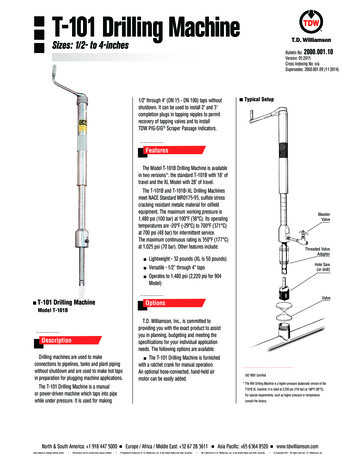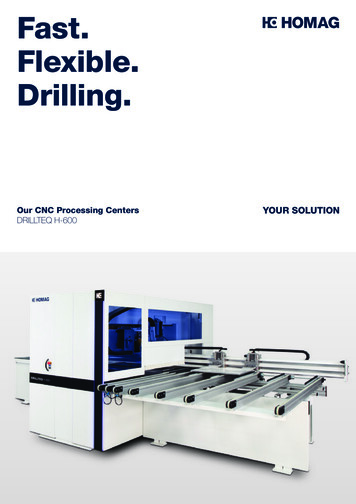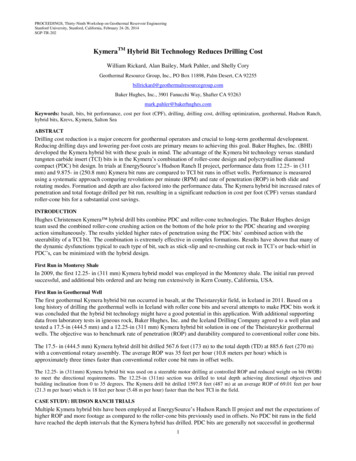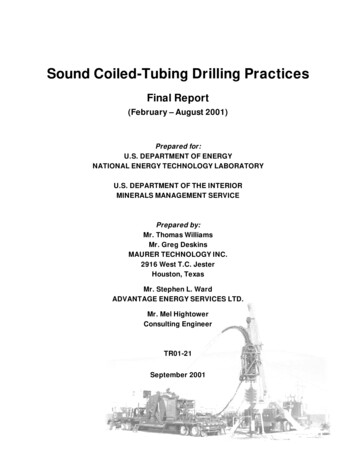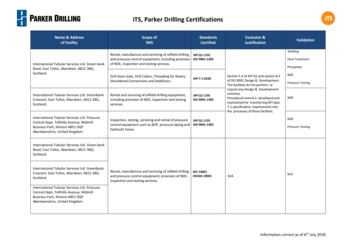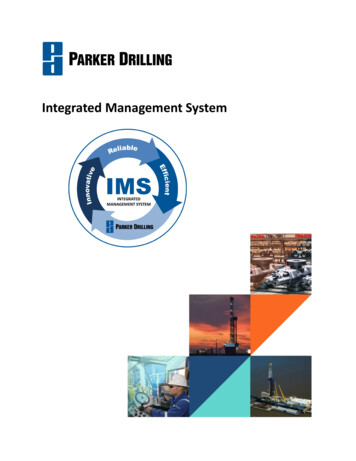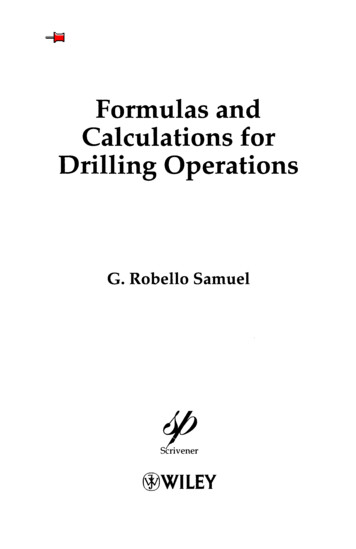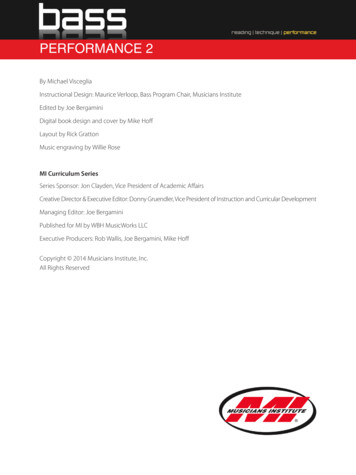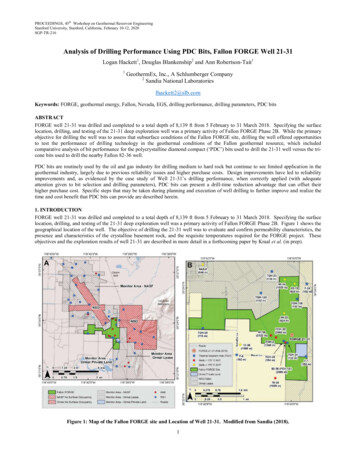
Transcription
PROCEEDINGS, 45th Workshop on Geothermal Reservoir EngineeringStanford University, Stanford, California, February 10-12, 2020SGP-TR-216Analysis of Drilling Performance Using PDC Bits, Fallon FORGE Well 21-31Logan Hackett1, Douglas Blankenship2 and Ann Robertson-Tait11GeothermEx, Inc., A Schlumberger Company2Sandia National Laboratorieslhackett2@slb.comKeywords: FORGE, geothermal energy, Fallon, Nevada, EGS, drilling performance, drilling parameters, PDC bitsABSTRACTFORGE well 21-31 was drilled and completed to a total depth of 8,139 ft from 5 February to 31 March 2018. Specifying the surfacelocation, drilling, and testing of the 21-31 deep exploration well was a primary activity of Fallon FORGE Phase 2B. While the primaryobjective for drilling the well was to assess that subsurface conditions of the Fallon FORGE site, drilling the well offered opportunitiesto test the performance of drilling technology in the geothermal conditions of the Fallon geothermal resource, which includedcomparative analysis of bit performance for the polycrystalline diamond compact (‘PDC’) bits used to drill the 21-31 well versus the tricone bits used to drill the nearby Fallon 82-36 well.PDC bits are routinely used by the oil and gas industry for drilling medium to hard rock but continue to see limited application in thegeothermal industry, largely due to previous reliability issues and higher purchase costs. Design improvements have led to reliabilityimprovements and, as evidenced by the case study of Well 21-31’s drilling performance, when correctly applied (with adequateattention given to bit selection and drilling parameters), PDC bits can present a drill-time reduction advantage that can offset theirhigher purchase cost. Specific steps that may be taken during planning and execution of well drilling to further improve and realize thetime and cost benefit that PDC bits can provide are described herein.1. INTRODUCTIONFORGE well 21-31 was drilled and completed to a total depth of 8,139 ft from 5 February to 31 March 2018. Specifying the surfacelocation, drilling, and testing of the 21-31 deep exploration well was a primary activity of Fallon FORGE Phase 2B. Figure 1 shows thegeographical location of the well. The objective of drilling the 21-31 well was to evaluate and confirm permeability characteristics, thepresence and characteristics of the crystalline basement rock, and the requisite temperatures required for the FORGE project. Theseobjectives and the exploration results of well 21-31 are described in more detail in a forthcoming paper by Kraal et al. (in prep).Figure 1: Map of the Fallon FORGE site and Location of Well 21-31. Modified from Sandia (2018).1
Hackett et al.A secondary objective of the 21-31 well was testing the performance of drilling technology in the geothermal conditions of the Fallongeothermal resource. Review and summary of drilling performance is the topic of this paper, which includes: An analysis of days-versus-depth for 21-31 and a comparison to off-set well 82-36, which is also located within the Fallonproject area. A summary of drilling results for each section (including a record of bits and the bottom-hole assemblies (‘BHAs’)) usedduring the drilling process. Comparison of bit performance (e.g., rate-of-penetration (‘ROP’), mechanical specific energy (‘MSE’ (i.e., the energyrequired to remove a unit volume of rock)), wear, and footage cost) for the different polycrystalline diamond compact (‘PDC’)bits used to drill the 21-31 well versus the tri-cone bits used to drill the nearby 82-36 well.All depths in this report are referenced to the rig floor (KB), 22 ft above ground level. The well was drilled by Ormat Nevada Inc.(“Ormat”) on behalf of the Fallon FORGE team. The well is located at Section 30, T18N, R30E in Churchill County, Nevada.Drilling was conducted using Rig 6 from Paul Graham Drilling, Inc. from Rio Vista, California. Rig 6 is a 1,000 HP conventional landrig, with a box-on-box substructure and a double derrick that is hydraulically raised, and cable scoped. The rig is rated for a maximumdepth of 10,500 ft with 4-1/2-in drill pipe. It has two Gardner Denver PZ-9, 1,000 HP triplex pumps and a total active drilling fluidcapacity of 400 barrels.Drilling engineering and supervision were conducted by Ormat. Well site geology and mud logging were provided by Horizon WellLogging (HWL). Directional equipment services were provided by Scientific Drilling, Inc. (SDI). Cementing services were providedby Resource Cementing (Rio Vista, California). Mud engineering and supplies were provided by Sinclair Well Products. All drill bitsused in drilling well 21-31 were PDC bits (or PDC hybrid bits), primarily manufactured by National Oilwell Varco (NOV) (one bit wasmanufactured by Security) and supplied by San Joaquin Bit Service.Well 21-31 was spudded on 5 February 2018 at 3:00 AM, and the rig was released at 8:30 AM on 31 March 2018, after a total of 55days. The total active time spent was 862.5 hours. A detailed analysis of the time by activity (including non-productive time) ispresented in Table 1. The Rimbase drilling monitoring program was used for summary and analysis of well 21-31 data describedherein.Table 2: Well 21-31 Operational Time Analysis2
Hackett et al.The well was spudded from the bottom of the 20-in conductor pipe, which had been cemented at a depth of 130 ft (KB). The well wasdrilled in three sections: 17-1/2-in from 130 ft to 910 ft; 12-1/4-in from 910 ft to 6,058 ft; and 8-1/2-in from 6,058 to 8,100 ft. A totalof 9 BHAs and 9 drilling bits (including 1 re-run) were used in the drilling operation (see Tables 2 – 3 for details of BHAs and drillingbits used).Table 2: Well 21-31 BHA Summary ReportBit Summary ReportWell ID:FORGE 21-31GEOTHERMEX, INC.Well Name: FORGE 21-31Sect: 30 Town: 18N Rng: 30E County: Churchill State: NVRunNo No Diam Manuf.ModelSerial NoNozzles - 1/32 inTFADate/Time InDepth (ft)InOutHoleROPWOBFlowMade (ft) Hrs (ft/hr) AVG (lbf) RPM (gal/m) MWt Major Loc BrgGrading Gge Oth PullWell ID:FORGE 21-31Cost ( )Cost ( )/ftNotesWell Name: FORGE 21-311117.500 NOVTFX519SE11871814 14 14 14 140.752 02-Feb-18 03:3013011 NOAX1 NOTD2112.250 SECR24AMPK7175216 16 160.589 10-Feb-18 08:0091091000.00.0000 9.003112.250 NOVSKH716DE15228616 16 16 16 16 16 16 1.374 12-Feb-18 8754 9.10750 9.2021 CTNX1 NOBHA 29,875.00 See re-run4112.250 NOVE716A20678116 16 16 16 16 16 16 1.374 15-Feb-18 16:153406438297672.613.419600166720 9.2011 PNAX1 NOBHA 29,875.005212.250 NOVSKH716DE15228615 15 15 15 15 15 15 1.208 20-Feb-18 12:0043826058167666.525.217300161706 9.6021 CTAX1 NOTDRe-Run 7.16618.500 NOVE716A18838815 15 15 15 15 15 15 1.208 02-Mar-18 15:306058656250419.326.213500190550 8.5021 CTNX1 NOHP 19,500.00 38.69718.500 NOVE716A18738715 15 15 15 15 15 15 1.208 06-Mar-18 22:006562689433226.012.820600179598 8.5032 WTAX1 NOBHA 19,650.00 59.19818.500 NOVFT76A24735716 16 16 12 12 120.920 08-Mar-18 19:006894756166732.420.614000195590 8.5021 CTNX1 WTBHA 45,150.00 67.69918.500 NOVFT76A24735616 16 16 12 12 120.920 10-Mar-18 19:307561810053923.023.520800208600 8.5022 CTNX1 WTTD 83.77 36,000.00 16,875.00 45,150.00 46.15-Milled tooth 30.61Bit re-runTable 3: Well 21-31 BHA Summary ReportThe well was drilled vertically from surface with directional control and was actively steered to the depth of the last casing string.Directional drilling continued with a motor in the open hole where a very small angle (3 degrees) was developed in the SW directionfrom 7,000 ft to TD (8,100 ft). The maximum horizontal well departure at 8,100 ft from its surface location was 81 ft. A boreholeschematic is provided on Figure 2.3
Hackett et al.Figure 2: Well 21-31 Borehole SchematicAn 8-1/2-in coring bit and a 40-ft core barrel were used to core the interval from 8,100 ft to 8,139 ft, recovering less than one foot ofcore.A series of geophysical logs was run in the open hole, including Schlumberger’s Triple Combo, sonic and caliper logs from 300 to6,062 ft; dipole sonic, FMI and external temperature from 6,055 to 8,109 ft; and Triple Combo (MT-LEH-STGC-QILE-QCNT-HLDTQAIT) from 5,970 ft to 8,139 ft. Analysis of wireline geophysical logging are summarized in Kraal et al. (in prep) and Perdana et al.(2020). Sidewall cores (1-1/2-in x 3-in and 1 x 2-in) were then cut at multiple depths, ranging from 8,075 through 6,435 ft, retrieving atotal of 45 sidewall core samples.Well testing by injection took place on two different occasions: 4 March and 13-15 March 2018. These testing activities are describedin more detail within Kraal et al. (in prep).As completed, well 21-31 conforms very closely to its intended program. Provided below is a discussion of the results obtained fromthe various PDC bits used to drill the well intervals. Also described below is a comparison of the drilling results of well 21-31 withnearby well 82-36, located in the Fallon project area (Figure 1). The 82-36 wellhead is approximately 2,000 ft south-west from thelocation of 21-31.2. DRILLING SUMMARYThe construction of the drilling pad for well 21-31 began on 13 January 2018. A 20-in conductor pipe was set using a small rat-holedigger rig and cemented at an approximate depth of 110 ft below surface level (132 ft KB). Paul Graham’s Rig 6 was moved to the 2131 wellsite between 25 January and 4 February 2018 and drilling commenced on 5 February 2018.4
Hackett et al.A summary of time spent in drilling the well, separated by category (including non-productive time), is presented on a graph on Figure3.Figure 3: Well 21-31 Operations Time GraphThe first stage of the well (17-1/2-in) was drilled from the bottom of the conductor pipe during February 5 and 6. The 13-3/8-in, K-55,68 lb/ft, buttress-threaded casing was set at the depth of 910 ft. This stage was drilled with a single 17-1/2-in PDC bit (Bit #1), whichdrilled a total of 780 ft in 10.5 hours, corresponding to a rate of penetration (ROP) of approximately 74.4 ft per hour (ft/h). Nocirculation losses or formation problems were reported for this interval. Table 3 summarizes bit details including model, nozzlearrangement, date/time in, footage drilled, hours, ROP, bit cost, cost/ft, etc. for each bit used to drill 21-31.The 13-3/8-in casing was cemented by pumping 223 barrels of Therma-Lite, 13 pounds per gallon (lbm/gal) lead slurry, followed by 51barrels of Therma-Tail, 15 ppg tail cement slurry. An approximate volume of 80 barrels of cement slurry returned to surface and no topjobs were needed.After drilling out the casing shoe, a casing shoe integrity test failed when pressured to a formation fracture gradient of 0.61 psi/ft. Thesection below the shoe was squeezed and cement was allowed to set, after which it passed a casing shoe integrity test of 0.57 psi/ft.Drilling of the 12-1/4-in hole continued between 12 and 24 February 2018, from 910 ft to 6,058 ft using BHA’s 2 – 5 (Table 2). A totalof 3 PDC bits (with the 3rd bit being a re-run of the 1st) were used to drill 5,148 ft in approximately 192 drilling hours, with an averageROP of 28.5 ft/h. Individual bits and their associated drilling parameters and performance (on average) were as follows: Bit #3: ROP (46.8 ft/h); depth in/out (910/3,406 ft); hours (53.2); WOB avg (4,800 lbf); RPM (108); flow (750 gal/min). Forthis bit, the WOB and MSE are considered relatively low (Figure 4). Bit #4: ROP (13.4 ft/h); depth in/out (3,406/4,382 ft); hours (72.6); WOB avg (19,600 lbf); RPM (166); flow (720 gal/min).For this bit, ROP was relatively low, while WOB, RPM, MSE, and torque were high. The ROP of Bit #4 is noted to havebeen caused by a missing nozzle that was not installed by the drilling team prior to tripping the bit into the well. Bit #5: ROP (25.2 ft/h); depth in/out (4,382/6,058 ft); hours (66.5); WOB avg (17,300 lbf); RPM (161); flow (706 gal/min).This bit (a re-run of Bit #3) showed improved ROP (compared to Bit #4), with similar if somewhat higher WOB, similar RPMand torque, and significantly lower MSE.5
Hackett et al.Figure 4: Well Construction, Geology, and Drilling Parameters for the Fallon FORGE 21-31 WellBit #3 performed appreciably better than Bit #4, and a bit trip was made specifically to inspect Bit #4 and then to replace it with a re-runof Bit #3. The re-run Bit #3 (referred to as Bit #5 above and on Table 3) did not achieve the same ROP as its first run but againoutperformed Bit #4. Cumulatively, Bits #3 and #5 achieved a notable 7.16/ft of drilled hole (i.e., bit cost/total footage drilled), whichis significantly better than Bit #4’s 30.61/ft. The individual cost and the cost/ft determined for each bit are provided on Table 3. Wenote that footage costs are interesting to evaluate, but may not be particularly meaningful for well 21-31 because the bits were not run to6
Hackett et al.the end of their useful life, as is often done when drilling conventional wells. For well 82-36, 12-1/4-in tricone bit cost was notavailable, which would allow a comparison of whether PDC bits were more profitable than the tricone bits in the Fallon conditions.On 25 February geophysical logs were run in the 12-1/4-in open wellbore with a Platform Express Quad Combo (density, neutronporosity, resistivity, and Sonic Scanner (e.g., compressional shear, Stoneley slownesses, and waveform)) from 300 to 6,062 ft. Theselogs are summarized in Kraal et al. (in prep) and Perdana et al. (2020).The 9-5/8-in, J-55, 40 lb/ft, buttress-threaded casing was set at the depth of 6,058 ft and was cemented by pumping 635 barrels ofTherma-Lite HT, 13.5 ppg lead slurry, followed by 41 barrels of Therma-Tail, 15 ppg tail cement slurry. Partial cement returns wereexperienced while pumping the lead cement, and total losses occurred while pumping the tail cement portion. A decision was made toflush the annular space with water and pump 94 barrels of 13.5 ppg Therma-Lite HT cement slurry through the annulus, followed bysqueezing 20 barrels of 13.5 ppg RC
used in drilling well 21-31 were PDC bits (or PDC hybrid bits), primarily manufactured by National Oilwell Varco (NOV) (one bit was manufactured by Security) and supplied by San Joaquin Bit Service. Well 21-31 was spudded on 5 February 2018 at 3:00 AM, and the rig was released at 8:30 AM on 31 March 2018, after a total of 55 days. The total active time spent was 862.5 hours. A detailed analysis of the time by
